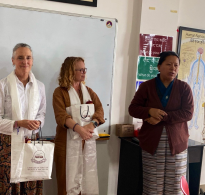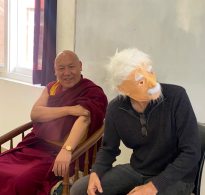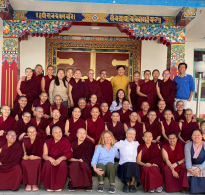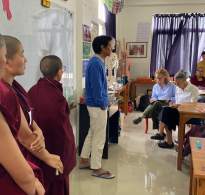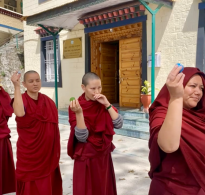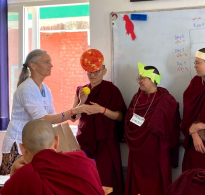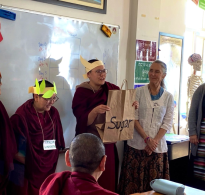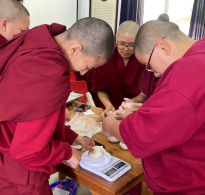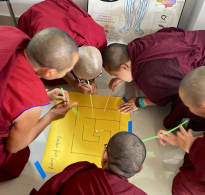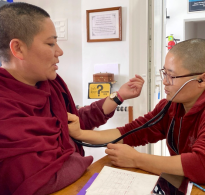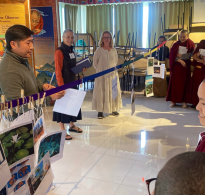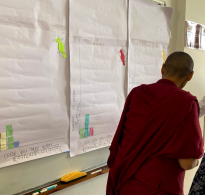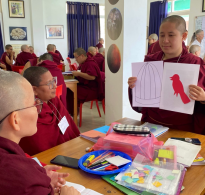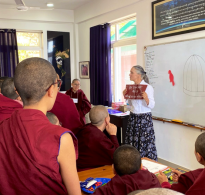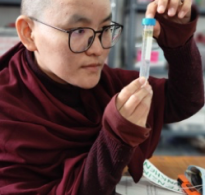2nd Cohort Nuns’ Leadership Program
(11-31 March, 2024)

The second cohort nuns’ leadership program commenced on March 11th at LTWA, Dharamsala for three weeks and it lasted till March 31st, 2024. This year we had 40 nuns from 4 different nunneries, and most of them are learning science for the first time. The three-week rigorous science learning program was designed as, for the first week teachers from the science department of LTWA had conducted the classes whereas, they brushed up on the basics to prepare them for the second and third week. And guest teachers took over the class for the second and third week.
Lori and Tammy engaged in multiple educational activities over a two-week period. They explored visual adaptation and learned about the parts and functions of the human eye. The class observed plant and animal cells under microscopes, dissected flowers to study their anatomy, conducted a seed germination experiment to understand plant growth, and participated in hands-on activities related to sensory adaptation. These experiences imparted them with a deep understanding of topics ranging from biology to sensory perception, making their two weeks highly constructive and enriching.
Chris Impey taught an astronomy class covering diverse topics over a period. Initially, students expressed their visions of the universe through drawings. Subsequently, they delved into the historical narrative of the universe and solar systems. Hands-on activities interpreted the size and position of Earth and the Moon. He also integrated sessions on measurement and probability into the curriculum. As the class concluded, he engaged students in a discussion focusing on clarifying misconceptions about the nature of science. Throughout, the class aimed to foster a refined understanding of astronomy incorporated with critical thinking and scientific inquiry.
This program is organised and coordinated by the Science Department of the Library of Tibetan Works and Archives in collaboration with Science for Monks and Nuns, which is funded by the Sager Family Foundation and the Templeton Foundation.
About the teachers:

Tammy Cook-Endres
Tammy is a science educator for seventeen years, she has taught elementary and middle school science and has mentored and coached novice science teachers through programs such as Peninsula Bridge, Breakthrough San Francisco, and the Exploratorium’s Teacher Induction Program. She earned her biology degree at the University of California, Santa Cruz, and her master’s degree in science education at Teachers College, Columbia University. A National Board Certified Teacher in Early Adolescent Science, she is passionate about crafting learning opportunities for all students that ignite a love of science. And is she dedicated to finding the best ways to support STEM teachers in creating classrooms that do just that.

Lori Lambertson
Lori studied biology and dance at the University of California, Santa Cruz, where she also had a brief but thrilling career as a professional bicycle racer. She completed a BFA with an emphasis in painting at the University of San Francisco, and an MA in education from San Francisco State University, where she also earned her teaching credentials. Lori taught both math and science at the middle school level. She attended the Summer Institute in 1991, which was a life-changing experience. In 1996, she left classroom teaching to work as a Teacher-in-Residence in the Exploratorium’s Teacher Institute (TI). Lori co-authored The Math Explorer, and has had teaching experiences in India and Costa Rica and throughout the United States. She enjoys hula dancing, learning Spanish, painting, gardening, cooking, hiking, and surfing.

Chris Impey
Chris Impey is a University Distinguished Professor. For 17 years he was Deputy Head of the Astronomy Department at the University of Arizona, and he is currently Associate Dean of the College of Science. He has over 220 refereed publications and 80 conference proceedings in astronomy and 100 publications on educational topics. His work has been supported by $20 million in grants from NASA and the NSF. As a professor, he has won eleven teaching awards, and has been heavily involved in curriculum and instructional technology development. He has mentored 30 graduate students and 250 undergraduates. Chris Impey is a past Vice President of the American Astronomical Society. He has also been an NSF Distinguished Teaching Scholar, a Phi Beta Kappa Visiting Scholar, and Carnegie Council on Teaching’s Arizona Professor of the Year. He was a co-chair of the Education and Public Outreach Study Group for the 2010 Decadal Survey of the National Academy of Sciences. In 2009 he was elected Fellow of the American Association for the Advancement of Science, and in 2014 he was the first astronomer named a Howard Hughes Medical Institute Professor.


